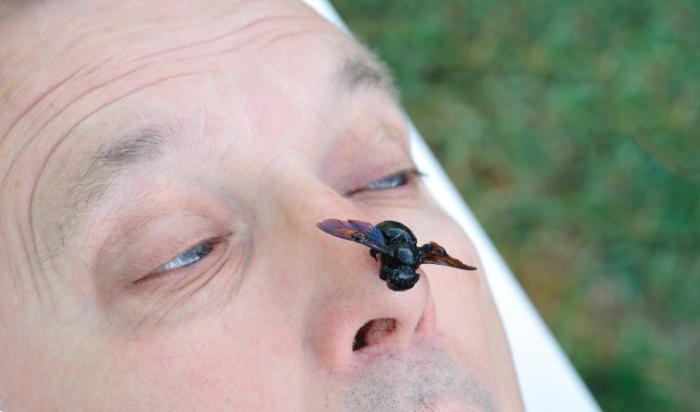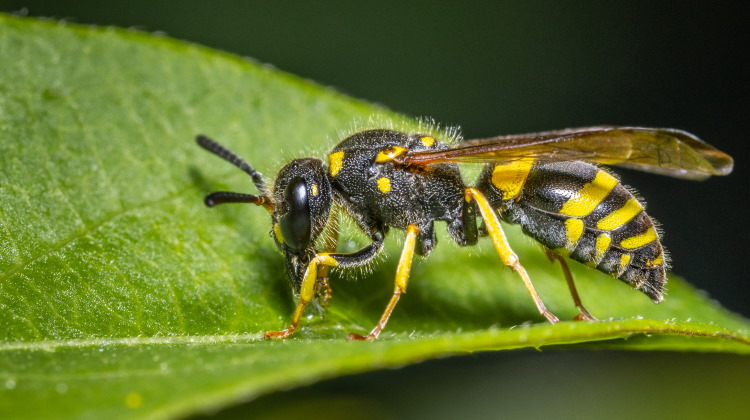Wasps are good-for-nothing creatures that enjoy the company of humans as well as honey bees, and are protected. They don’t gather honey nor are they friends or social, they’re angry and furious and always ready to strike and unlike honey bees , who when stinging must remove the sting the wasps are able to attack multiple times and not leave the sting, which makes them are able to feel superior and cause injury to humans and other animals.
The bee doesn’t make the sting go away, but it draws it in through the slide of the barbed. … If honey bees sting an individual, it’s not able to draw the barbed stinger out. It leaves behind not just the stinger but also an abdominal part and digestive tract, along with nerves and muscles.
Their appearance can vary greatly based on their species. They typically have two pairs of wings as well as a pinched waist. They come in a variety of colors, from metallic greens to black and blues, and range in size from microscopic to several centimeters in length. Each one of them has a sting. very few of them use it to kill prey, while others use it to display their superiority.

Types of Wasps — Social Wasps and Solitary Wasps
There are two kinds of wasps: social wasps and solitary. The social wasps , such as Yellow Jackets, Hornets, and Paper Wasps usually have a greater number of individuals than solitary wasps such as Mud Daubers or Cicada Killers. The stinging isps belong to the family known as Vespidae. The solitary wasps can also sting however they are primarily used to subdue prey (the single wasps seldom hurt humans).One method to recognize an stinging wasp is look at their wings when they’re at rest. The wings fold in a long way, making them appear to be half as long as they really are. The majority of wasps construct their nests out of wood fibers, creating the appearance of a paper shelter. The wasps stay inactive throughout winter, and hide under protective covers. The queen builds nests, and feeds young larvae.
Social Wasps

The Bald-faced Hornet, European or giant hornet and Yellow Jackets are all prominent wasps that infest structures. Yellow Jackets Yellow Jackets have the distinction of being the tiniest among the common Vespids. They are part of the Vespid family are socially beneficial wasps which are found in colonies of many thousands. Hornets can be a danger because of their natural tendency of nesting in attics, structural voids and in any cavity within landscaping elements. Their diet is ripe fruits in vineyards and gardens.
Food shortages during winter force them to seek refuge in warm places, and they seek out human-made structures.
The typical “wasp” body kind: A small, narrow attachment between the thorax and abdomen, which is shaped like a spindle and is tipped with long stingers. The abdomen and thorax are brightly colored with red, yellow or brown against black background. A lot of hornets confuse yellow jackets.
Yellow Jackets

Jackets with yellow feature bright yellow and black patterns. As a social wasp they are aggressive in protecting their nests. Yellow Jackets have slim waists while bees have a larger waist. They usually build their nests on the ground. They eat meats and sweets.
Control One of the best method is to find and treat nests during night. If you’re unable to treat the nest you can use bait stations for yellow jackets which are efficient.
Solitary Wasps

The sole wasps comprise Sphecid wasps. Cicada Killers, Mud Daubers, Potter Wasps, Spider Hunter , Cricket hunter wasps are part of this category. The species has a female who builds one nest or a variety of nests. They don’t fold their wings when flying as social wasps do. Certain solitary construct their nests in the soil similar to digger as well as Cicada killers.
Prevention is better than cure
- Secure all entry points Look for pipes and windows and even the exhaust fan hole or the main door that is not closed by children, they could get in from any location. If they’ve already walked into your office or home look up their flight route particularly in the morning. This will allow you to determine the time and date they entered and decide to take appropriate action.
- Get rid of all food sources Keep all food waste in a sealed container. the pantry can be a place to dispose of trash and your backyard must be kept clean and inconsiderate. Be mindful of the three essentials of water, food, and shelter. Every living thing is searching for three of these. If you do have trees, make sure you clean the fallen fruit as soon as possible because they could fall from the rotten fruit that is laid in the dirt.
- Avoid swatting. Squashing and swatting is not beneficial. When a wasp gets squashed by it releases a chemical (pheromone) releases that draws and incites nearby. It’s better to stay away from a wasp that is hovering.
- Avoid wearing bright colors as well as floral prints. If you appear like a large flower, you could attract the curious seeking nectar.
- Avoid the use of perfumes or other scents that are strong.
Conclusion
Certain species of wasps can be so aggressive and arrogant, they can sting without need in nature and sting innocent pets such as cats and gods at home and make their lives miserable.
Are you looking for Wasps control in Calgary?
Having Wasps around is a nuisance and getting rid of them is another headache. Not just that, having Wasps is not lovely. So, put your trust in Topline to help you get rid of the Wasps. They are only a call away.
Dial now!
For more information and hire professional services, please contact us on 4038133666

